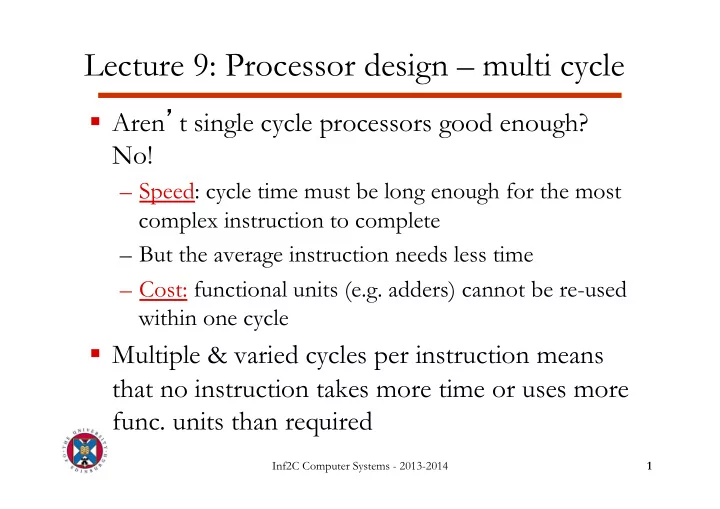

Lecture 9: Processor design – multi cycle § Aren ’ t single cycle processors good enough? No! – Speed: cycle time must be long enough for the most complex instruction to complete – But the average instruction needs less time – Cost: functional units (e.g. adders) cannot be re-used within one cycle § Multiple & varied cycles per instruction means that no instruction takes more time or uses more func. units than required Inf2C Computer Systems - 2013-2014 1
Lecture outline § Brief processor performance evaluation § Determine the components § Build the datapath § Build the control Inf2C Computer Systems - 2013-2014 2
Measuring processor speed Execution time is instruction count x cycles per instruction x cycle time Inf2C Computer Systems - 2013-2014 3
Determine the components Processor task Component list § Instruction fetch from § PC register memory § Memory (instructions) § Read registers § Adder: PC+4 § Execution § Register file – Data processing – 2 read, 1 write instructions § ALU – Data transfer instructions – Branch instructions Inf2C Computer Systems - 2013-2014 4
Design guidelines § Cycle time determined by the delay through the slowest functional unit § Reuse functional units as much as possible – Multiplexors added to select the different inputs § At end of each cycle, data required in subsequent cycles must be stored somewhere – Data for other instructions are kept in the memory, register file, or the PC – Data for same instruction are kept in new registers not visible to the programmer Inf2C Computer Systems - 2013-2014 5
Multi-cycle datapath Inf2C Computer Systems - 2013-2014 6
How to design the control part § The control unit of a multicycle processor is an FSM § Determine exactly what happens in each cycle § and what is the next step § Be careful with register load-enable control signals Inf2C Computer Systems - 2013-2014 7
What happens in each cycle – 1 & 2 1. Instruction fetch IR <= Mem[PC] PC <= PC+4 2. Instruction decode and register fetch A <= Reg[IR[25:21]] B <= Reg[IR[20:16]] ALUOut <= PC+sgnext(IR[15:0]<<2) Inf2C Computer Systems - 2013-2014 8
Cycle 1 – instruction fetch (all) Inf2C Computer Systems - 2013-2014 9
Cycle 2 –instr decode & reg read (all) Inf2C Computer Systems - 2013-2014 10
What happens in each cycle – 3 3a. Memory address generation ALUOut <= A+sgnext(IR[15:0]) 3b. R-type arithmetic-logical instruction ALUOut <= A op B 3c. Branch completion if (A == B) PC <= ALUOut 3d. Jump completion PC <= {PC[31:28],IR[25:0],2’b00} Inf2C Computer Systems - 2013-2014 11
Cycle 3a: add imm arg (addi, lw, sw) Inf2C Computer Systems - 2013-2014 12
Cycle 3b: R-type ALU op (add, and) Inf2C Computer Systems - 2013-2014 13
Cycle 3c: Branch taken (beq, bne) Inf2C Computer Systems - 2013-2014 14
Cycle 3d: jump (j) Inf2C Computer Systems - 2013-2014 15
What happens in each cycle – 4 4a. Memory access (load) MDR <= Mem[ALUOut] 4b. Memory access (store) & completion Mem[ALUOut] <= B 4c. R-type arith-logical instruction completion Reg[IR[15:11]] = ALUOut Inf2C Computer Systems - 2013-2014 16
Cycle 4a: Load from mem (lw) Inf2C Computer Systems - 2013-2014 17
Cycle 4b: Store to mem (sw) Inf2C Computer Systems - 2013-2014 18
Cycle 4c: R-type result write (add, and) Inf2C Computer Systems - 2013-2014 19
What happens in each cycle – 5 5. Load instruction completion Reg[IR[20:16]] <= MDR Inf2C Computer Systems - 2013-2014 20
Cycle 5: save of loaded value (lw) Inf2C Computer Systems - 2013-2014 21
State diagram 0 1 Inf2C Computer Systems - 2013-2014 22
Recommend
More recommend